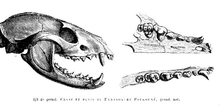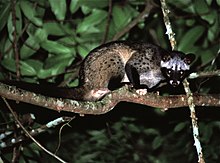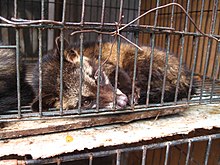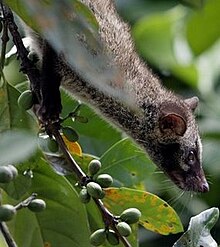椰子貓
| 椰子貓[1] | |
|---|---|

| |
| 科學分類 | |
| 界: | 動物界 Animalia |
| 門: | 脊索動物門 Chordata |
| 綱: | 哺乳綱 Mammalia |
| 目: | 食肉目 Carnivora |
| 科: | 靈貓科 Viverridae |
| 屬: | 椰子貓屬 Paradoxurus |
| 種: | 椰子貓[1] P. hermaphroditus
|
| 二名法 | |
| Paradoxurus hermaphroditus (Pallas, 1777)
| |

| |
| 椰子貓分布範圍,綠色為原產地,紅色部分則為人為引入。 | |
椰子貓(學名:Paradoxurus hermaphroditus),又名椰子貍,為分布於南亞及東南亞的一種麝貓。因為椰子貓可以廣泛的適應各類棲息地,種群數量沒有減少的趨勢,因此IUCN紅色名錄將其列為無危物種。[3][4] 在印度尼西亞,椰子貓受到偷獵與非法野生動物交易的威脅。售出的椰子貓被囚禁生產貓屎咖啡,以滿足不斷增長的市場需求。[5]
特徵
[編輯]
椰子貓平均重2-5公斤,體長53厘米,尾巴長48厘米。牠們的毛粗糙,一般呈灰色,腳、耳朵及吻都是黑色的。牠們的身體上有三間黑色斑紋,面部的斑紋則像浣熊,前額和鼻孔側邊有白色毛髮,雙眼之間有細黑線,尾巴沒有斑紋。椰子貓尾巴下有嗅腺,形狀像睪丸,可以分泌令人不適的物質,作為化學防禦手段。[6]
分布
[編輯]
椰子貓原生分佈於印度、尼泊爾、孟加拉國、不丹、緬甸、斯里蘭卡、泰國、新加坡、馬來半島、沙巴、砂拉越、汶萊、寮國、柬埔寨、越南、中國、菲律賓,以及印度尼西亞的蘇門答臘島、爪哇島、加里曼丹、巴韋安島和西比路島。此外,它還被引進到了西巴布亞、小巽他群島、摩鹿加群島和蘇拉威西島。[3]
在中國境內,椰子貓主要分布在海南、廣西、四川、貴州、廣東、雲南。[7]
在巴拉望採集的椰子貓標本與婆羅洲的在遺傳學上相似,因此生活在巴拉望島上的椰子貓可能是更新世時期從婆羅洲擴散過去的。並且有可能後來的人們將椰子貓引入到了菲律賓的其它島嶼上。[8][9]
棲息地
[編輯]
椰子貓通常生活在原始森林,但偶爾也在次生林和選擇性伐木森林發現小規模團體。[10] 椰子貓是樹棲動物,常與果子貍、鼯鼠、巨松鼠、長臂猿等在同一環境中棲息,喜好住在古木樹洞等蔭蔽條件。[7][11]
有時椰子貓也出現在公園或郊區園林,它們會在有成熟果實的果樹、榕樹或植被上活動。它們藉助尖利的爪子攀爬樹木或房屋水管。對斯里蘭卡當地人而言,椰子貓是一種惱人的動物,因為牠們會在天花板及室內排泄,並且經常製造噪音,擾人清夢。
習性
[編輯]
除交配時期外,椰子貓在大部分時間都是獨居生活。它同時適應陸棲與樹棲,是夜行性動物。[10] 椰子貓的活動時間從傍晚至第二天凌晨四時左右,活動高峰在深夜至凌晨時分,但在月光較亮時會減少活動強度。[10][12]
不同性別的椰子貓對其它個體的尿液、糞便以及肛門腺分泌物有不同的領地標記和嗅覺反應。最常見的標記方式是通過拖動會陰腺在地面留下氣味標記。因個體性別與分泌物的不同,嗅覺反應的持續時間各有差異。通過分析會陰腺留下的氣味標記,椰子貓可以識別出對方的品種、性別,並判斷其是否為陌生個體。[13]
飲食
[編輯]椰子貓是雜食動物,它們主要食用水果,例如漿果和多汁水果。它們可幫助植物散播種子,因此有助於維持原始森林的生態平衡。[10] 椰子貓的食物包括人心果、芒果、紅毛丹、咖啡豆,此外它們也會捕食小昆蟲和小型哺乳動物。它們在格德潘拉貢山國家公園的山檳榔(Pinanga kuhlii 和 Pinanga zavana)自然再生中扮演著重要角色。[14] 椰子貓也食用糖棕花液,發酵後的糖棕花液可被製作為棕櫚酒,人們將這種棕櫚酒稱為「toddy」,因為椰子貓的這個習性,人們也將椰子貓稱為「toddy cat」。
繁殖
[編輯]由於椰子貓獨居與夜行的生活方式,有關其交配的行為與過程仍知之甚少。[15] 2010年3月,曾有一對椰子貓被觀察到交配嘗試,它們在樹上交配,時間約為5分鐘。在此期間,雄性個體爬到雌性身上,而後短暫分開,然後又重複這一過程,一共進行了4-5次。交配完成後,雙方仍在一起嬉戲,在樹枝間跳躍。大約6分鐘後,雙方分開,各自移動到不同樹枝上,並在那裡休憩。[16]
生存現狀
[編輯]捕獵與囚禁
[編輯]
在亞洲某些地區,椰子貓是捕獵的目標,人們用其製作叢林肉,並販賣它的毛皮。[17] 在中國南部,由於棲息地破壞和過度狩獵,椰子貓在野外多數地區已難尋蹤跡。[11] 從1998至2003年,在印度哥印拜陀、泰米爾納德邦、阿格拉、北方邦都有發現當地部落將椰子貓作為食物的行為。[3] 在斯里蘭卡,當地人會將椰子貓的肉浸在亞麻仁油,儲存在陶器內,定時日照,用煶煉出的油醫治疥瘡。[18] 貓屎咖啡來自於椰子貓食用並經消化排出的咖啡豆。傳統上的貓屎咖啡是由人們從野外採集的,但是面對不斷上升的消費需求,人們開始從野外捕捉椰子貓,將其囚禁以生產貓屎咖啡。這些椰子貓被關在層疊籠里,生存環境惡劣。[19][20] 被囚禁的椰子貓無法獲得足夠的水果,而是被餵食大量咖啡豆以提高「產出」。椰子貓需要利用骨骼中的鈣質分解這些過量的咖啡因,因此身體逐漸變得虛弱。[21] 目前尚不清楚消費者對貓屎咖啡的需求會對野外椰子貓種群數量有多大影響,但很可能構成了巨大的威脅。印度尼西亞針對作為椰子貓捕捉設定了配額,但這個配額很可能已經被超出。[5]
保護
[編輯]
椰子貓已被列入瀕危野生動植物種國際貿易公約附錄三。[3] 印度尼西亞對野外可捕捉的椰子貓數量設定了配額,並僅允許其中的10%在國內銷售。然而,這個配額基本已被獵人與交易商所無視,當局也未對此採取強制措施。[22] 近年來,在印度尼西亞流行將椰子貓作為寵物,這造成了爪哇島和峇里島市場中出現大量待銷售的椰子貓。大部分作為寵物的椰子貓都是從野外捕獲的。鑑於捕獵者對捕捉配額的無視,以及當局的無作為,椰子貓的生存境況不容樂觀。[17]
與人類的關係
[編輯]
神話
[編輯]在菲律賓神話中,巴格博人信奉一個身形巨大、擁有強大能力的椰子貓神Lakivot。根據神話敘述,為尋找黃金之花,Lakivot擊敗了眾多怪物,包括獨眼怪Ogassi和守衛黃金之樹的布索人。最終,Lakivot變幻成了一個英俊的年輕人,並將黃金之花獻給了他的妻子。[23]
貓屎咖啡
[編輯]咖啡豆被椰子貓食用後,在椰子貓的消化道內發酵並最終被排出體外,這種咖啡被稱為貓屎咖啡。經過這一過程,小果咖啡和中果咖啡中的咖啡因含量都有降低。[24] 流變學測試顯示,相比對照組,經過椰子貓消化的咖啡豆更硬、更脆,這表明椰子貓的胃酸侵入了咖啡豆,改變了其中的微小結構。胃酸中的蛋白酶或許在其中起到關鍵作用,它能夠分解咖啡豆中的蛋白質。[25]
分類
[編輯]
彼得·西蒙·帕拉斯在1777年創造了學名Viverra hermaphrodita[26],這個名稱被用在了分布於斯里蘭卡和印度南部至訥爾默達河的椰子貓指名亞種。[27] 從1820-1992年間,有一些相關的動物學標本被記錄了下來:[28]
- P. h. balicus(由Sody在1933年的峇里島記錄)
- P. h. bondar(安塞爾姆·加埃唐·德馬雷, 1820, 孟加拉管轄區)
- P. h. canescens (Lyon, 1907)
- P. h. canus (Miller, 1913)
- P. h. cochinensis (Schwarz, 1911)
- P. h. dongfangensis (Corbet and Hill, 1992)
- P. h. enganus (Lyon, 1916)
- P. h. exitus (Schwarz, 1911)
- P. h. hermaphroditus
- P. h. javanica (Thomas Horsfield, 1824, 爪哇島)
- P. h. kangeanus (奧德菲爾德·托馬斯, 1910)
- P. h. laotum (Nils Carl Gustaf Fersen Gyldenstolpe, 1917, 清邁, 分布於緬甸、印度支那和海南島)
- P. h. lignicolor (格里特·史密斯·米勒, 1903)
- P. h. milleri (塞西爾·博登·克洛斯, 1908)
- P. h. minor (John Lewis Bonhote,1903)
- P. h. musanga (Stamford Raffles, 1821, 蘇門答臘)
- P. h. nictitans (Taylor, 1891, 奧里薩邦)[29]
- P. h. pallasii (約翰·愛德華·格雷, 1832, 印度)[30]
- P. h. pallens (Miller, 1913)
- P. h. parvus (Miller, 1913)
- P. h. philippinensis ( Claude Jourdan, 1837, 菲律賓)
- P. h. pugnax (Miller, 1913)
- P. h. pulcher (Miller, 1913)
- P. h. sacer (Miller, 1913)
- P. h. scindiae ( Pocock, 1934, 瓜廖爾, 分布於印度中部)
- P. h. senex (Miller, 1913)
- P. h. setosus (Honoré Jacquinot and Pucheran, 1853)
- P. h. simplex (Miller, 1913)
- P. h. sumbanus (Ernst Schwarz, 1910)
- P. h. vellerosus (Pocock, 1934, 克什米爾)
參考
[編輯]- ^ Wozencraft, W.C. Order Carnivora. Wilson, D.E. & Reeder, D.M. (編). Mammal Species of the World: A Taxonomic and Geographic Reference (3rd ed.). Baltimore, Maryland: Johns Hopkins University Press. 2005: 551. ISBN 978-0-8018-8221-0. LCCN 2005001870. OCLC 62265494. NLC 001238428.
- ^ Duckworth, J.W., Widmann P., Custodio, C., Gonzalez, J.C., Jennings, A. & Veron, G. Paradoxurus hermaphroditus. The IUCN Red List of Threatened Species 2008. [2009-03-13].
- ^ 3.0 3.1 3.2 3.3 IUCN. Paradoxurus hermaphroditus: Duckworth, J.W., Timmins, R.J., Choudhury, A., Chutipong, W., Willcox, D.H.A., Mudappa, D., Rahman, H., Widmann, P., Wilting, A. & Xu, W.: The IUCN Red List of Threatened Species 2016: e.T41693A45217835. 2015-03-03 [2022-07-11]. doi:10.2305/iucn.uk.2016-1.rlts.t41693a45217835.en. (原始內容存檔於2018-10-07) (英語).
- ^ Paradoxurus hermaphroditus (Common Palm Civet) (頁面存檔備份,存於網際網路檔案館) - IUCN Red Listed
- ^ 5.0 5.1 Shepherd, C. (2012). "Observations of small carnivores in Jakarta wildlife markets, Indonesia, with notes on trade in Javan Ferret Badger Melogale orientalis and on the increasing demand for Common Palm Civet Paradoxurus hermaphroditus for civet coffee production (頁面存檔備份,存於網際網路檔案館)". Small Carnivore Conservation. 47: 38–41.
- ^ Lēkhakun, B.; McNeely, J. A. (1977). Mammals of Thailand. Bangkok: Association for the Conservation of Wildlife.
- ^ 7.0 7.1 中国动物主题数据库 - 椰子狸 Paradoxurus hermaphroditus. zoology.especies.cn. [2022-07-14]. (原始內容存檔於2022-07-14).
- ^ Patou, Marie-Lilith; Wilting, Andreas; Gaubert, Philippe; Esselstyn, Jacob A.; Cruaud, Corinne; Jennings, Andrew P.; Fickel, Jörns; Veron, Géraldine. Evolutionary history of the Paradoxurus palm civets - a new model for Asian biogeography: Phylogeography of Asian Paradoxurus palm civets. Journal of Biogeography. 2010-11, 37 (11) [2022-07-12]. doi:10.1111/j.1365-2699.2010.02364.x. (原始內容存檔於2022-10-05) (英語).
- ^ Piper, Philip J.; Ochoa, Janine; Robles, Emil C.; Lewis, Helen; Paz, Victor. Palaeozoology of Palawan Island, Philippines. Quaternary International. Quaternary Floral and Faunal Assemblages: Ecological and Taphonomical Investigations. 2011-03-15, 233 (2) [2022-07-12]. ISSN 1040-6182. doi:10.1016/j.quaint.2010.07.009. (原始內容存檔於2019-07-22) (英語).
- ^ 10.0 10.1 10.2 10.3 Grassman, L.I. Jr. (1998). "Movements and fruit selection of two Paradoxurinae species in a dry evergreen forest in Southern Thailand". Small Carnivore Conservation (19): 25–29.
- ^ 11.0 11.1 汪, 松. 中国濒危动物红皮书, 兽类. 北京: 科學出版社. 1998 [2022-07-14]. ISBN 978-7-03-006400-4. OCLC 298158389. (原始內容存檔於2022-07-14) (中文).
- ^ Joshi, Anup R.; David Smith, James L.; Cuthbert, Francesca J. Influence of Food Distribution and Predation Pressure on Spacing Behavior in Palm Civets. Journal of Mammalogy. 1995-12-04, 76 (4). ISSN 0022-2372. doi:10.2307/1382613.
- ^ Rozhnov, V. V.; Rozhnov, Yu. V. Roles of Different Types of Excretions in Mediated Communication by Scent Marks of the Common Palm Civet, Paradoxurus hermaphroditus Pallas, 1777 (Mammalia, Carnivora). Biology Bulletin of the Russian Academy of Sciences. 2003-11-01, 30 (6). ISSN 1608-3059. doi:10.1023/B:BIBU.0000007715.24555.ed (英語).
- ^ Thohari, M.; Santosa, Y. (1986). A preliminary study on the role of civet (Paradoxurus hermaphroditus) in the natural regeneration of palms (Pinanga kuhlii and P. zavana) at Gunung Gede-Pangrango National Park, West Java (Indonesia). Symposium on Forest Regeneration in Southeast Asia, 9–11 May 1984. Biotrop Special Publication. pp. 151–153.
- ^ Prater, S. H. (1980). The book of Indian animals (Second ed.). Bombay, India: Bombay Natural History Society.
- ^ Borah, J.; Deka, K. (2011). "An observation of Common Palm Civet Paradoxurus hermaphroditus mating". Small Carnivore Conservation. 44: 32–33.
- ^ 17.0 17.1 Nijman, V.; Spaan, D.; Rode-Margono, E. J.; Roberts, P. D.; Wirdateti; Nekaris, K. A. I. (2014). "Trade in common palm civet Paradoxurus hermaphroditus in Javan and Balinese markets, Indonesia". Small Carnivore Conservation (51): 11−17.
- ^ Singh, L. A. K. Stomach Contents of a Common Palm Civet, Paradoxurus hermaphroditus (Pallas). J. Bombay Nat. Hist. Soc. 1982, 79 (2): 403–404.
- ^ World's most expensive coffee tainted by 'horrific' civet abuse. the Guardian. 2012-11-19 [2022-07-12]. (原始內容存檔於2013-08-02) (英語).
- ^ Excreted by Imprisoned Civets, Kopi Luwak No Longer a Personal Favorite | The Jakarta Globe. web.archive.org. 2013-01-16 [2022-07-12]. 原始內容存檔於2013-01-16.
- ^ Animal cruelty claims over civet cat coffee. ABC News. 2015-04-12 [2022-07-14]. (原始內容存檔於2022-09-24) (澳大利亞英語).
- ^ Shepherd, C. R. (2008). Civets in trade in Medan, North Sumatra, Indonesia (1997–2001) with notes on legal protection Archived January 29, 2015, at the Wayback Machine. Small Carnivore Conservation 38: 34–36.
- ^ Esteban, R. C. (2011). Folktales of Southern Philippines. Manila: Anvil Publishers.
- ^ Mahendradatta, M.; Tawali, A. B. (2012). Comparison of chemical characteristics and sensory value between luwak coffee and original coffee from Arabica (Coffea arabica L) and Robusta (Coffea canephora L) varieties (頁面存檔備份,存於網際網路檔案館) (PDF). Makassar: Food Science and Technology Study Program, Department of Agricultural Technology, Faculty of Agriculture, Hasanuddin University.
- ^ Marcone, Massimo F. Composition and properties of Indonesian palm civet coffee (Kopi Luwak) and Ethiopian civet coffee. Food Research International. 2004-01-01, 37 (9) [2022-07-12]. ISSN 0963-9969. doi:10.1016/j.foodres.2004.05.008. (原始內容存檔於2018-10-25) (英語).
- ^ Pallas, P. S. (1778). "Das Zwitterstinkthier". In Schreber, J. C. D. (ed.). Die Säugethiere in Abbildungen nach der Natur, mit Beschreibungen. Erlangen: Wolfgang Walther. p. 426.
- ^ Reginald Innes Pocock. PocockMammalia1. : 387–415.
- ^ Wilson, Don E.; Reeder, DeeAnn M. Mammal species of the world : a taxonomic and geographic reference 3rd ed. Baltimore: Johns Hopkins University Press. 2005: 532–628 [2022-07-11]. ISBN 0-8018-8221-4. OCLC 57557352. (原始內容存檔於2020-09-28).
- ^ Pocock, R. I. (1939). "Paradoxurus hermaphroditus". The Fauna of British India, including Ceylon and Burma. Vol. 1. Mammalia. London: Taylor and Francis. pp. 387–415.
- ^ Gray, J.E. (1832). "Pallas's Paradoxurus". Illustrations of Indian zoology; chiefly selected from the collection of Major-General Hardwicke. London: Treuttel, Wurtz, Treuttel, Jun. and Richter. pp. Plate 8.

